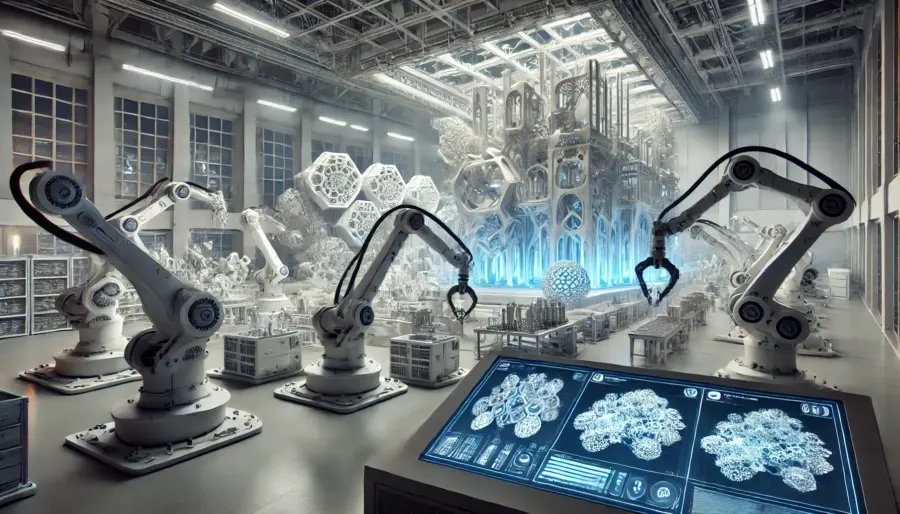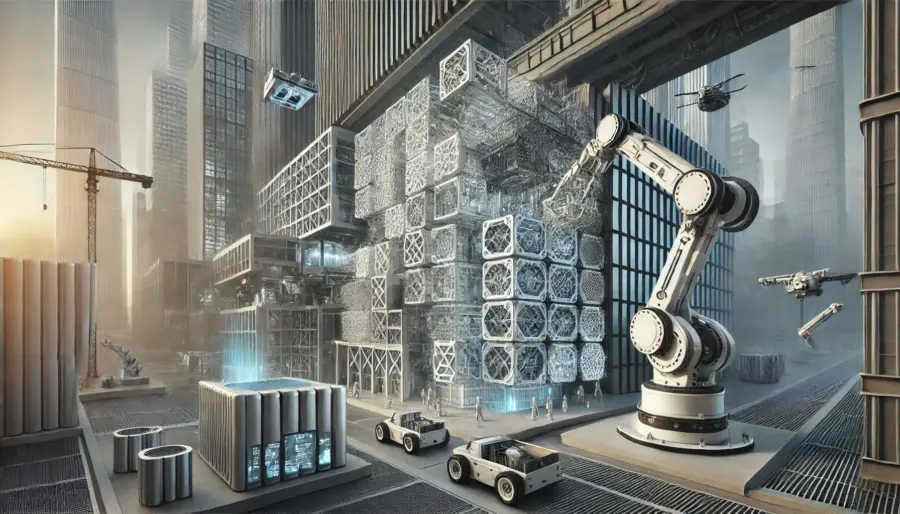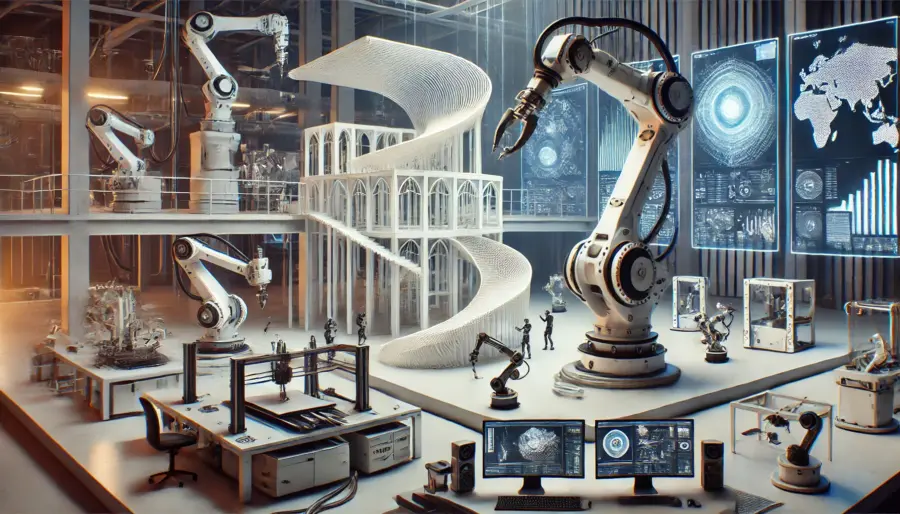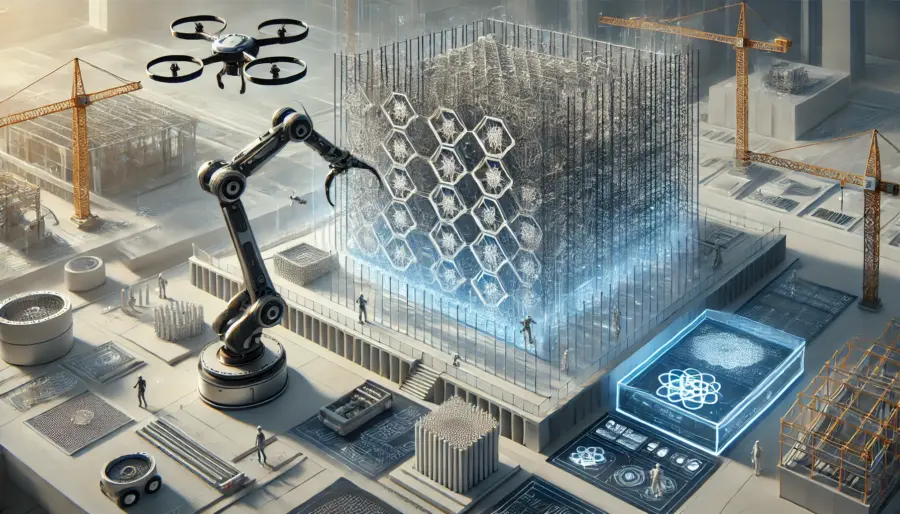Digital Fabrication and Robotics in Architecture: Shaping the Future of Design and Construction
Steps in your green building process
BY JOSEPH AZAR
March 2025

Introduction
The architectural landscape is undergoing a profound transformation with the integration of digital fabrication and robotics. These advanced technologies are not only redefining how buildings are designed and constructed but also addressing key global challenges like sustainability, labor shortages, and housing crises. This article explores the intersection of digital fabrication and robotics in architecture, examining their evolution, current applications, and the future possibilities they unlock.
The shift from traditional, labor-intensive construction to automated, digitally-driven processes represents more than a technological advancement—it signifies a new architectural paradigm. Architects and designers are now empowered to push the boundaries of creativity while maintaining high levels of precision, efficiency, and environmental responsibility.
1. Understanding Digital Fabrication in Architecture
Digital fabrication refers to the process of using computer-controlled machines to convert digital designs into physical objects. In architecture, this encompasses a range of techniques, including:
- Additive Manufacturing (3D Printing): Layering materials to build objects directly from digital models.
- Subtractive Manufacturing (CNC Milling and Laser Cutting): Removing material to shape components with extreme precision.
- Robotic Fabrication: Utilizing industrial robots to perform complex construction tasks, including assembly and bespoke material manipulation.
Evolution of Digital Fabrication
Historically, architectural fabrication relied on manual craftsmanship and industrial manufacturing. With the advent of Computer-Aided Design (CAD) and Building Information Modeling (BIM) in the 1980s and 1990s, the architectural process began to integrate digital workflows. These tools allowed architects to visualize and test complex forms but still required conventional construction techniques.
The early 2000s marked a turning point as advances in digital fabrication made it possible to directly translate digital designs into physical reality. Institutions like the Massachusetts Institute of Technology (MIT) and ETH Zurich became pioneers, pushing research in computational design and robotic fabrication. Notable projects like the “Silk Pavilion” by the MIT Media Lab, which combines biological processes with digital control, illustrate how these technologies extend beyond conventional methods.
2. Robotics in Architecture: Precision and Automation
Robotics is revolutionizing construction through precision, efficiency, and the ability to execute tasks that are labor-intensive or hazardous for humans. In architectural contexts, robotics plays a crucial role in:
- Construction Automation: Robots can automate tasks like bricklaying, welding, and concrete printing.
- Prefabrication: Robotic arms fabricate modular building components with high accuracy.
- On-Site Assembly: Autonomous machines assist in assembling complex structures in real-time.
Case Study: DFAB House, Switzerland
One of the most prominent examples of robotic integration is the DFAB House, completed in 2019 by ETH Zurich. This multi-story structure combines several digital fabrication techniques:
- Mesh Mould Technology: Robots fabricate a complex metal framework filled with concrete, eliminating the need for traditional formwork.
- Robotic Timber Construction: Robots precisely cut and assemble wooden modules.
- Smart Slab: 3D-printed molds create lightweight, structurally optimized concrete slabs.
The DFAB House exemplifies how digital fabrication and robotics can create structures that are not only aesthetically striking but also environmentally efficient.
3. The Synergy Between Digital Fabrication and Robotics
The convergence of digital fabrication and robotics creates new possibilities for architectural innovation. This synergy allows for:
- Complex Geometries: Designs once considered impossible due to manual constraints are now feasible.
- Mass Customization: Customized elements can be produced without increasing costs, unlike traditional mass production.
- Material Efficiency: Digital precision reduces waste through optimized material usage.
BIM-to-Fabrication Workflows
Building Information Modeling (BIM) serves as the digital backbone linking design to fabrication. With BIM, architects create detailed, data-rich models that directly inform robotic processes. This seamless connection minimizes errors and facilitates the production of bespoke architectural components.
4. Addressing Global Challenges with Robotics and Digital Fabrication
The integration of these technologies provides solutions to some of the most pressing challenges in contemporary architecture:
- Housing Crises: Robotics enables rapid and cost-effective construction. For example, in 2023, a team in Chile used 3D concrete printing to construct Latin America’s first 3D-printed home, demonstrating how automation can alleviate housing shortages.
- Sustainability: Digital fabrication optimizes material use and reduces construction waste. This is crucial as the built environment accounts for approximately 39% of global carbon emissions.
- Labor Shortages: Automated systems mitigate the impact of declining labor availability by performing repetitive and dangerous tasks.
5. The Future of Architecture: Emerging Trends
Looking ahead, the future of architecture is poised to evolve through continued advancements in digital fabrication and robotics. Key trends include:
Autonomous Construction Sites
Fully automated construction environments, where robotic systems handle everything from excavation to assembly, will become increasingly common. Companies like Boston Dynamics are already deploying robotic dogs to monitor construction progress in real-time.
Smart Materials and Adaptive Architecture
The future will see the rise of smart materials that interact with environmental stimuli. For instance, 4D printing technology is exploring materials that can self-assemble or adjust to temperature changes.
Collaborative Design Ecosystems
AI and machine learning will foster collaborative design environments where architects and robotic systems co-create. This will allow for real-time optimization of form, structure, and performance.
6. Ethical and Social Considerations
While these technologies present immense opportunities, they also raise ethical and societal concerns:
- Labor Displacement: Increased automation could displace traditional construction workers, necessitating new skill development programs.
- Data Privacy: With advanced digital workflows, safeguarding intellectual property and sensitive project data is crucial.
- Access and Equity: Ensuring these innovations benefit underserved communities will be vital in promoting inclusive architectural practices.
7. Conclusion
Digital fabrication and robotics are not merely tools but transformative forces redefining the architectural landscape. From enabling unprecedented design complexity to addressing urgent societal challenges, these technologies position architecture at the forefront of innovation.
As architects, designers, and industry leaders continue to explore the potential of digital fabrication and robotics, the future promises a built environment that is smarter, more sustainable, and adaptable to the evolving needs of society. Embracing these advancements is not only an opportunity but a necessity for shaping the future of architecture.

Artist/Architect/ LEED AP (BD+C)
Computational/ Environmental design
Enjoyed this article? Discover more in the Blog section


